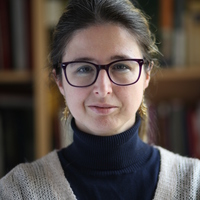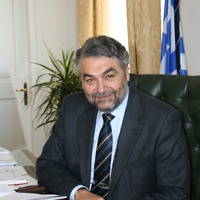Papers by Matteo Martelli

In the last two years, we have been working on a Graeco-Arabic edition of Book IX of Galen's On S... more In the last two years, we have been working on a Graeco-Arabic edition of Book IX of Galen's On Simple Drugs, which also takes into account an abridged Syri-ac version. The starting point was a non-negotiable complete recension of all the manuscript witnesses. Our aim is to look for the point of contact between the Greek and the Arabic traditions, understanding the complex process that brought about the translation, and from there to reach the most ancient stage of the Galenic tradition that it is possible to attain. This approach opens new dimensions for stemmatological and editorial discussion that deserve to be cautiously explored. Matteo Martelli and Lucia Raggetti Two years ago, we embarked on a joint philological enterprise aimed at producing a critical edition and English translation of the Greek and Arabic versions of Galen's On Simple Drugs, Book IX on minerals drugs. 1 We shall share here some aspects of the methodological approach that have oriented our work, together with the new ideas and intuitions that have emerged during our perusal of the text. Three crucial aspects of our research will be touched upon in this contribution: (1) the study of the two textual traditions in their own independent development; (2) the way in which these two traditions entered into contact and communicated with each other; (3) the selection of the variants in the larger historical context of the Graeco-Arabic textual tradition. It is not the first time that the Greek and the Arabic tradition of a Ga-lenic text have been considered together. 2 The aim of our investigation is the constitutio textus, id est, Graeci ac Arabici textus, the critical value of which depends upon a parallel and balanced use of both traditions.
Paper in a special issue of AION devoted to alchemy in the Western and Eastern traditions: "Elisi... more Paper in a special issue of AION devoted to alchemy in the Western and Eastern traditions: "Elisir mercuriale e immortalità", edited by Giacomella Orofino, Amneris Roselli, and Antonella Sannino, 2 volumes (2014 and 2015).
In: Eva Cancik-Kirschbaum, Anita Traniger (ed.), Wissen in Bewegung. Institution – Iteration – Tr... more In: Eva Cancik-Kirschbaum, Anita Traniger (ed.), Wissen in Bewegung. Institution – Iteration – Transfer, Wiesbaden: Harrassowitz, 2015
5 Del resto, nell'incipit del Protrettico (1,3 Boudon-Millot = 1,2 K.) gli stessi dèi sono presen... more 5 Del resto, nell'incipit del Protrettico (1,3 Boudon-Millot = 1,2 K.) gli stessi dèi sono presentati come cultori e maestri d'arte, e le τέχναι sono dette divine (θείαι) in quanto praticate dagli dèi (la medicina da Asclepio e il tirar d'arco, la musica e la divinazione da Apollo) e patrocinate dalle Muse.
ISBN 978 88 222 6384 1 -81 -matteo marteLLi DISSOlUzIOnI, DISTIllAzIOnI E PASSAGGI DI STATO nEl C... more ISBN 978 88 222 6384 1 -81 -matteo marteLLi DISSOlUzIOnI, DISTIllAzIOnI E PASSAGGI DI STATO nEl CORPUS DEGlI AlCHIMISTI GRECI *

What is Graeco-Egyptian alchemy? Which kinds of techniques and craft practices does it encompass?... more What is Graeco-Egyptian alchemy? Which kinds of techniques and craft practices does it encompass? And what were its goals? The paper addresses these questions by investigating the earliest Greek alchemical texts preserved both in Byzantine and in Syriac manuscripts. Already during the first centuries AD, in the Graeco-Roman Egypt it is possible to recognize some disagreement over the definition of alchemy and its expected outcomes. On the one hand, ps.-Democritus's four books and the Leiden and Stockholm papyri support a fourfold division of alchemy including processes for making gold, silver, and precious stones (glass working included), and for dyeing wool purple. On the other hand, Isis's treatise focuses only on the making of precious metals, which is identified with the main goal of alchemy during the late Byzantine tradition. In the process that led to such a simplification of the technical background of alchemy Zosimus's work seems to represent an important turning point. In fact the author inherited the above mentioned polarity and discussed different ideas of alchemy in a key text (here edited and translated into English for the first time) on the revelation of alchemy based on the Enochian myth of the fallen angels.
The text presents a preliminary study of the textual tradition, the exegetic typologies, and the ... more The text presents a preliminary study of the textual tradition, the exegetic typologies, and the sources of a Byzantine alchemical lexicon (CAAG II 4,11-17,17). The lexicon is to be understood
in the framework of the exegetical activity undertaken by late antique and Byzantine alchemical authors. The sources of a few entries may be identified with some alchemical texts preserved in Byzantine manuscripts (e.g. Ps.-Democritus) and by the Oriental tradition (e.g. Zosimus in Syriac translation).

Per una nuova edizione commentata di un lessico alchemico bizantino * Das Peinliche dabei einen T... more Per una nuova edizione commentata di un lessico alchemico bizantino * Das Peinliche dabei einen Text herausgeben zu müssen, den ich sachlich nicht verstehe, empfinde ich gewiß schwerer als meine Vorgänger Ideler […] und Berthelot; allein, da die beiden trefflichen Naturforscher Berthelot und sein scharfer Kritiker, E. v. Lippmann […] bei dem philologischen Teil der Aufgabe versagt haben, muß der Philologe mithelfen, auch wenn er dem naturwissen schaftlichen Teil nicht Genüge tun kann. (Reitzenstein 1919, 1s.) 5 Il passo di Zosimo è tramandato solo in una citazione di Sincello ed in traduzione siriaca (cf. CMA II 238s.). 6 Per una recente edizione dell'opera, intitolata Συνεσίου φιλοσόφου πρὸς Διόσκορον εἰς τὴν βίβλον Δημοκρίτου ὡς ἐν σχολίοις, si veda Martelli 2011, 224-253 (= CAAG II 56-69). 7 Si vedano Sezgin, GAS IV 75 n. 6 e Ullmann 1972, 163; si tratta dell'inedito Kitāb Mafātīḥ aṣan'a, "Libro sulle chiavi dell'arte", i cui possibili rapporti con la tradizione bizantina rimangono da investigare. Le opere di Zosimo conservate in greco, comunque, confermano il forte interesse dell'alchimista panopolitano verso gli scritti pseudo-democritei (cf. Martelli 2011, 76-83). 8 Una linea orizzontale separa quest'ultima sezione, introdotta dall'intestazione ἐκ τοῦ Διοσκουρίδου (sic) περὶ ὕλης, dalle precedenti 99 ricette che descrivono tecniche di metallurgia e di tintura della lana in porpora; cf. Leemans 1885, 243-249. Halleux (1981, 109) non riedita questa parte del papiro, ma riporta solo la lista delle sostanze seguite dal riferimento al testo dioscorideo. 9 L'identificazione della sostanza è problematica; il termine si riferiva probabilmente a minerali di ferro e rame in diversi stati di alterazione (cf. Bailey 1932, 175s.).
A recently new discovered passage from Galen’s On Simple Drugs, book ix, is here for the first ti... more A recently new discovered passage from Galen’s On Simple Drugs, book ix, is here for the first time edited and commented. The passage, handed down in the ms. Urb. Gr. 67, discusses the different names of the Armenian earth and preserves some interesting remarks on the use of ancient digamma. In addition, a close analysis of both the indirect and the Oriental tradition confirms the attribution of the passage to Galen.
The paper focuses on the alchemical laboratory of ancient Greco-Egyptian alchemists, by taking in... more The paper focuses on the alchemical laboratory of ancient Greco-Egyptian alchemists, by taking into account especially the earliest alchemical texts (both in the Greek and in the Syriac tradition), ascribed to Pseudo-Democritus, Maria the Jewish and Zosimus. The fijirst part analyzes the possible relationships between the workshops of Egyptian craftsmen (fijirst of all, dyers, metals workers and glass workers) and the activity of the alchemists. The second part gives a general overview on the alchemical instruments described in the Corpus alchemicum .
Una storia dell’alchimia nei testi alchemici greci: il cosiddetto Filosofo Anonimo (CAAG, vol. II, pp. 424, l. 6 – 425, l. 9), in C. Pogliano, M. Frank (ed.), Scorci di Storia della Scienza, Pisa: Edizioni Universitarie Plus, 2010, pp. 37-54
E. Bacchi, M. Martelli (2009), “Il principe Ḫālid B. Yazīd e l’origine dell’alchimia araba”, ‘Uyûn al-Akhbâr, Studi sul mondo islamico, 3, Conflitti e dissensi nell’Islâm, pp. 85-120., Oct 2009
The name of the chemical solution qe‹on Ûdwr (divine water) or qe…ou Ûdwr (sulfur water) is chara... more The name of the chemical solution qe‹on Ûdwr (divine water) or qe…ou Ûdwr (sulfur water) is characterised by semantic ambiguity: the term theion means both "divine" and "sulfur," and Greek alchemists frequently play on this polysemy. This article analyses the use of this and similar expressions in the writings of pseudo-Democritus from both a technical and a philological point of view. A fragment preserved by the alchemists Moses and Synesius shows that pseudo-Democritus knows two different kinds of this "water," the second of which recalls a recipe found in the chemical Leiden Papyrus, and that the composition of the substance determines the form of its name.











Uploads
Papers by Matteo Martelli
in the framework of the exegetical activity undertaken by late antique and Byzantine alchemical authors. The sources of a few entries may be identified with some alchemical texts preserved in Byzantine manuscripts (e.g. Ps.-Democritus) and by the Oriental tradition (e.g. Zosimus in Syriac translation).
in the framework of the exegetical activity undertaken by late antique and Byzantine alchemical authors. The sources of a few entries may be identified with some alchemical texts preserved in Byzantine manuscripts (e.g. Ps.-Democritus) and by the Oriental tradition (e.g. Zosimus in Syriac translation).
Lunedì 30 Marzo 2015
Mattina
09.00 – 09.30: Saluti del Dipartimento di Studi Umanistici, dell’Associazione Culturale Studentesca Chiron e Apertura dei Lavori.
09.30 – 10.15: Jean-Yves Guillaumin (Université de Franche-Comté): La creazione del vocabolario latino della geometria e dell'aritmetica.
10.15 – 11.00: Fabio Gasti (Università di Pavia): Fonti tecniche e fonti letterarie nelle Etymologiae di Isidoro di Siviglia.
11.00 – 11.15: Coffee Break
11.15 – 12.00: Philippe Mudry (Univrsité de Lausanne): Scienza greca o scienza romana? L'esempio della medicina.
12.00 – 12.45: Sabrina Grimaudo (Università di Palermo): Interpretazione e uso dei sogni nella scienza greco-romana.
Pomeriggio
15.00 – 16.45: Federica Cordano (Università di Milano): Disegnare una città greca.
15.45 – 16.30: Franco Ferrari (Università di Salerno): Lo schiavo di Menone, l'esperimento geometrico e la differenza tra episteme e alethes doxa.
16.30 – 16.45: Tea Break
16.45 – 17.30: Ferruccio Franco Repellini (Università di Milano): Alcuni modi antichi di guardare il cielo.
17.30 – 18.15: Lorenzo Verderame (“Sapienza” Università di Roma): L’osservazione celeste nell’Assiria del VII sec. a.C. (previsione, osservazione, dibattito)
Martedì 31 Marzo 2015
Mattina
09.30 – 10.15: Matteo Martelli (Humboldt-Universität zu Berlin): I libri alchemici pseudo democritei tra Oriente e Occidente.
10.15 – 11.00: Eleonora Rocconi (Università di Pavia): Saperi tecnici e aggettivazione dei suoni musicali: la qualità della ligyrotes.
11.00 – 11.15: Coffee Break
11.15 – 12.45: Interventi liberi: Studiare oggi i saperi tecnico-scientifici antichi e tardoantichi.
12.45 – 13.00: Chiusura dei Lavori
The workshop is an activity of the research project “Alchemy in Byzantium” of the Institute of Historical Research, National Hellenic Research Foundation (coordinator: Gerasimos Merianos). It is also the first of a series of scientific events on the history of alchemy, labeled “Alchemical Dialogues”, an initiative undertaken in collaboration with Matteo Martelli, University of Bologna.
Workshop organizer
Gerasimos Merianos, National Hellenic Research Foundation
Organizing assistant
Vangelis Koutalis, University of Ioannina